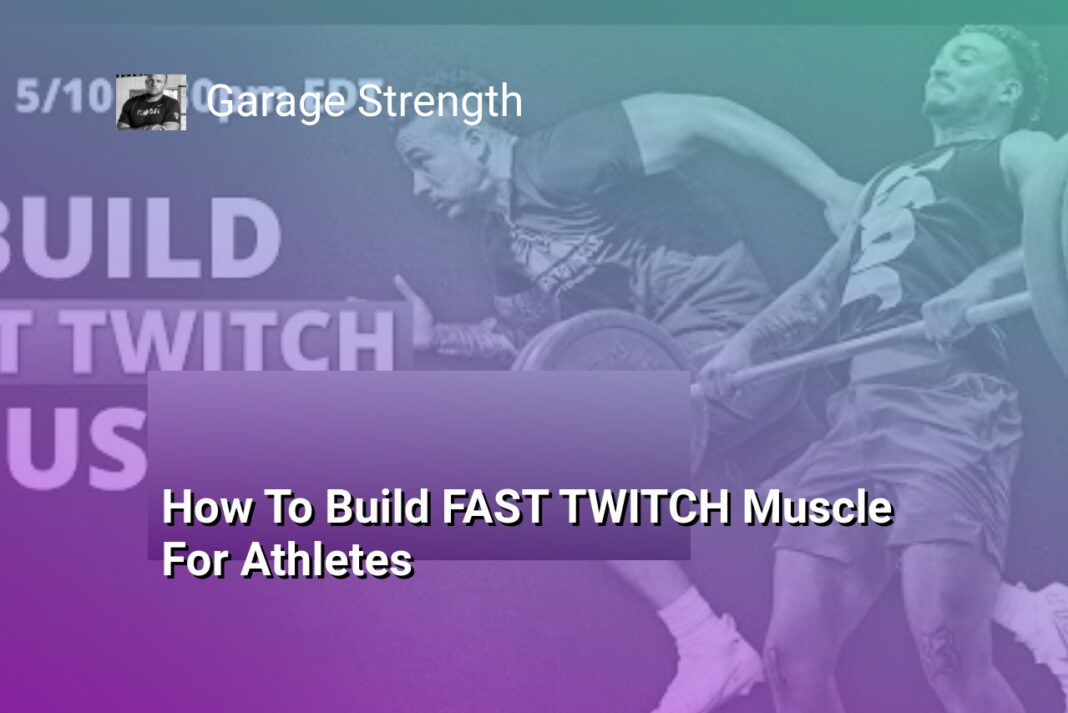The Bottom Line:
- The main theme of the text is the difference between fast-twitch and slow-twitch muscle fibers, and how they relate to sports performance and training.
- The text explains that fast-twitch muscle fibers are capable of producing high amounts of force and power, but fatigue quickly, while slow-twitch muscle fibers are more resistant to fatigue and better suited for endurance activities.
- The author uses an analogy of firewood to illustrate the difference, where fast-twitch fibers are like fast-burning, high-heat wood, while slow-twitch fibers are like slow-burning, long-lasting wood.
- The text also discusses the physiological aspects of muscle fibers, including the role of cross-sectional area and the relationship between myosin and actin heads in generating force.
- The author emphasizes the importance of understanding the differences between fast-twitch and slow-twitch muscle fibers in order to optimize sports performance and training strategies.
Understanding Slow Twitch and Fast Twitch Muscle Fibers
The Characteristics of Slow Twitch and Fast Twitch Muscle Fibers
Slow twitch muscle fibers, also known as type I fibers, are characterized by their resistance to fatigue. These fibers are well-suited for endurance activities, as they can sustain prolonged periods of exercise by efficiently utilizing fat as a primary fuel source. Slow twitch fibers have a higher concentration of mitochondria, which are the powerhouses of the cell, allowing them to generate energy through aerobic metabolism.
In contrast, fast twitch muscle fibers, or type II fibers, are designed for explosive, high-intensity movements. These fibers can generate a significant amount of force in a short period of time, but they fatigue more quickly due to their reliance on anaerobic glycolysis for energy production. Fast twitch fibers have a larger cross-sectional area, which enables them to recruit more myosin heads and actin binding sites, resulting in greater force output.
The Recruitment of Muscle Fibers
The recruitment of muscle fibers follows the Henneman size principle, which states that smaller, slower-twitch fibers are activated first, followed by the larger, faster-twitch fibers as the intensity of the movement increases. This principle is evident in everyday tasks, such as gently moving a pen, which primarily utilizes slow twitch fibers, versus forcefully bending the pen, which would engage the fast twitch fibers.
Practical Applications for Athletes
Understanding the differences between slow twitch and fast twitch muscle fibers is crucial for athletes and coaches in developing effective training programs. Endurance athletes, such as long-distance runners, typically have a higher proportion of slow twitch fibers, which allows them to maintain a steady pace over long distances. In contrast, power athletes, like sprinters, rely more on fast twitch fibers to generate explosive bursts of speed and power.
By recognizing the unique characteristics of these muscle fiber types, athletes and coaches can tailor their training regimens to target the specific needs of their sport, optimizing performance and reducing the risk of injury.
The Physiological Aspects of Fast Twitch Muscle Fibers
Metabolic Efficiency of Fast Twitch Muscle Fibers
Fast twitch muscle fibers are characterized by their ability to generate high levels of force and power, but they also come with a trade-off in terms of metabolic efficiency. These muscle fibers rely primarily on glycolytic energy systems, which produce ATP rapidly but can quickly deplete glycogen stores and lead to the accumulation of lactic acid.
Contractile Properties of Fast Twitch Fibers
The high force and power output of fast twitch muscle fibers is largely due to their structural and contractile properties. These fibers have a greater cross-sectional area, allowing them to recruit more myosin heads and actin binding sites to generate greater force. Additionally, they have a higher density of mitochondria, which enables them to produce ATP more quickly during high-intensity activities.
Fatigue Resistance of Fast Twitch Fibers
Despite their impressive force-generating capabilities, fast twitch muscle fibers are relatively fatigable compared to their slow twitch counterparts. The rapid depletion of glycogen and the buildup of metabolic byproducts, such as lactic acid, can lead to a rapid decline in force production during sustained or repeated high-intensity efforts. This trade-off between power and endurance is a key consideration in training and performance for activities that rely heavily on fast twitch muscle fibers.
Applying Fast Twitch Muscle Fiber Knowledge to Sports Performance
Maximizing Sports Performance with Fast Twitch Muscle Fiber Training
Understanding the distinct characteristics of fast twitch and slow twitch muscle fibers is crucial for optimizing sports performance. Fast twitch muscle fibers, known for their ability to generate high levels of force and power, are particularly valuable in explosive and high-intensity sports.
Harnessing the Power of Fast Twitch Fibers
Fast twitch muscle fibers are capable of producing a large amount of force in a short period of time, making them essential for activities that require rapid bursts of movement, such as sprinting, jumping, and weightlifting. By targeting the development of these fibers through specific training techniques, athletes can enhance their explosive power and speed, which can translate to improved performance in their respective sports.
Tailoring Training Strategies
To effectively train and harness the potential of fast twitch muscle fibers, athletes and coaches must employ a variety of targeted exercises and training methods. This may include high-intensity interval training, plyometric exercises, and explosive strength training. By carefully designing and implementing these training protocols, athletes can stimulate the growth and development of their fast twitch muscle fibers, leading to enhanced power output and overall sports performance.
Furthermore, understanding the physiological differences between fast twitch and slow twitch muscle fibers can help athletes and coaches make informed decisions about their training programs. For example, recognizing the higher energy demands and faster fatigue rates of fast twitch fibers can guide the implementation of appropriate recovery strategies and periodization within the training plan.
By applying the knowledge of fast twitch muscle fiber characteristics to their sports performance, athletes can unlock their full potential and gain a competitive edge in their respective disciplines. Through strategic training and a deep understanding of the underlying muscle fiber dynamics, athletes can harness the power of fast twitch fibers to achieve their performance goals.
Differentiating Between Fast Twitch and Slow Twitch Muscle Fibers
Exploring the Physiological Differences
To fully grasp the distinction between fast twitch and slow twitch muscle fibers, it’s essential to delve into their underlying physiological characteristics. Fast twitch muscle fibers, also known as type II fibers, are designed for explosive, high-intensity movements. These fibers are capable of generating a significant amount of force in a short period, but they fatigue quickly due to their high metabolic demands.
Fuel Utilization and Mitochondrial Density
In contrast, slow twitch muscle fibers, or type I fibers, are more efficient in their fuel utilization. They rely primarily on oxidative metabolism, which allows them to utilize fat as a primary energy source. Slow twitch fibers also have a higher density of mitochondria, the powerhouses of the cell, enabling them to sustain prolonged, low-intensity activities with greater resistance to fatigue.
Recruitment and Activation
The recruitment and activation of these muscle fiber types are governed by the size principle, which states that smaller, more fatigue-resistant slow twitch fibers are engaged first for low-intensity movements, while the larger, more powerful fast twitch fibers are recruited for high-intensity, explosive actions. This principle helps to ensure that the body efficiently utilizes its available resources, preserving the fast twitch fibers for when they are most needed.
By understanding the fundamental differences in the physiological characteristics of fast twitch and slow twitch muscle fibers, we can gain valuable insights into the specific demands and training requirements for various sports and physical activities. This knowledge can inform the development of targeted training programs and strategies to optimize athletic performance and physical fitness.
Announcements: Podcast Moves and Upcoming Guest
Podcast Moves and Upcoming Guest
We have some exciting announcements to share with you. First, we are moving our podcast to the main Garage Strength channel, where it will be streamed live every Tuesday. This means that whether we have a guest or it’s just Earl and I chatting, you’ll be able to catch the podcast on the main Garage Strength channel.
Additionally, our Garage Strength Podcast channel will now be dedicated to Garage Strength Clips. We’ll be pulling out 2-3 clips from each podcast episode and posting them on this channel, giving you the opportunity to watch 10-15 minute segments on specific topics. For example, we recently released a clip discussing how to develop a plyometric sequence for someone struggling with a particular movement.
Now, for the big announcement – we have a very popular guest joining us on the podcast this coming Tuesday. I want to encourage everyone to flood the comments and try to guess who this special guest is. We’ll be discussing slow-twitch and fast-twitch muscle fibers, diving into the research, and then I’ll reveal the identity of our guest.
Understanding Slow-Twitch and Fast-Twitch Muscle Fibers
To provide some context, when we discuss fast-twitch muscle fibers, it’s important to also understand what they are not – slow-twitch muscle fibers. Slow-twitch fibers are highly resistant to fatigue, as they are effective at utilizing fat for energy. They require less energy to contract and can maintain activity for extended periods. This is akin to burning a slow-burning, high-BTU firewood like locust or ash, which can provide sustained heat throughout the night.
In contrast, fast-twitch muscle fibers are like the quick-burning, high-intensity firewood like poplar. They can produce a massive amount of force and power in a short burst, but they fatigue quickly. This is due to their higher energy expenditure and the fact that they are not as resistant to fatigue as their slow-twitch counterparts.
Exploring the Physiological Aspects
The ability of fast-twitch fibers to generate more force is related to their larger cross-sectional area and the coordination between the myosin heads and actin heads within the muscle. The more myosin heads that can link to the actin heads, the more force the muscle can produce. This cross-sectional area and the relationship between the different muscle components play a crucial role in understanding the differences between slow-twitch and fast-twitch fibers.





